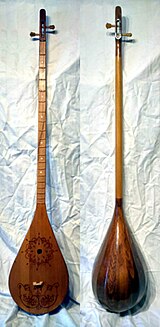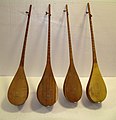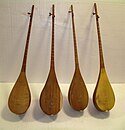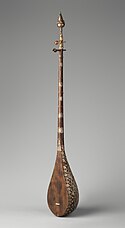Dutar
| Dutār | |
|---|---|
 | |
| Klasifikace | |
| Tónový rozsah | |
 | |
| Příbuzné nástroje | |
Dutār (někdy také dotar; persky: دوتار; rusky: Дутар; čínsky: 都塔尔, pchin-jinem: Dū tǎ ěr) je tradiční perský drnkací strunný nástroj (chordofon). Jedná se o typ taru (pražcové loutny s dlouhým krkem). Slovo dutār pochází z perštiny (دوتار) a doslovný překlad je „dvě struny“, kde du (دو) znamená „dvě“ a tar (تار) „struna“, ačkoli herátský dutar z Afghánistánu má struny tři. Kromě dutāru ještě rozlišujeme třístrunný setār (سهتار), čtyřstrunný tār (تار), pětistrunný penčtār (پنجتار) a šestistrunný šeštār (ششتار).
Dutar je velmi populární v Ázerbájdžánu, mezi Kurdy v Íránu (v provincii Chorásán, se kterou je silně spjat, hlavně s městem Torbat-e Jām), Kygyzstánu, Tádžikistánu, Turkmenistánu, Uzbekistánu a na západě Číny v Ujgurské autonomní oblasti. Mezi příbuzné nástroje patří kazašská dombra nebo středoasijský tanbur.[1][2][3]
Dutar je také nedílnou součástí turkmenské kultury (slavností, ceremonií, národních oslav, kulturních festivalů, společenských setkání a zábavních programů) a používá se ve všech hlavních žánrech turkmenské hudby a zpěvu. Ten, kdo hraje na dutar, je známý jako bachši (v Ázerbájdžánu jako ashiq). Hudba Chorásán bachši je od roku 2010 zapsaná na Seznamu nehmotného kulturního dědictví UNESCO,[4] stejně tak jako umění řemeslné výroby a tradiční hudební umění v kombinaci se zpěvem od roku 2021.[5]
Popis
Dutar je dlouhokrká dvoustrunná loutna s hruškovitým tělem, krytým tenkou dřevěnou rezonanční deskou. Tělo dutaru (ozvučnice) je vyrobeno z jednoho kusu morušového dřeva vydlabáváním z minimálně padesátiletého stromu. Rezonanční deska, kterou se přikrývá ozvučnice, je vyrobena také z morušového dřeva a peče se dvacet čtyři hodin, aby se odstranila vlhkost, a následně se lepí přes dutinu dutaru pomocí lepidla. Poté se přidá krk, který je vyroben z kmene meruňkovníku (stáří stromu 5–10 let). Nakonec je opatřen pražci ze střev či drátu a dvěma strunami ze střev, hedvábí či nylonu.[2][5]
Největší z dutarů je středoasijský dutar, který může dosahovat délky až cca 125 cm. Tělo je asi 15–20 cm široké a 13–17 cm hluboké. Navzdory rozdílům v proporcích, zvučnosti a výrobě mají všechny dotary (kromě moderního herátského dutaru) a mnoho dalších nástrojů (tanbury, dombry atd.) jeden společný rys: hraje se na obě struny současně vícero prsty pravé ruky (bez plektra) tak, aby tóny zněly od vysokých k nízkým.
- Pohled na přední stranu dutaru, cca 1860, Metropolitní muzeum umění (MET), New York, USA
- Pohled na zadní, zdobenou, stranu dutaru
- Íránské dotary v muzeu
Historie

Historie dutaru sahá až do 15. století, kdy byl používán především mezi pastýři a jeho struny byly vyrobeny ze zvířecích střev. S otevřením Hedvábné stezky se však začaly používat struny vyrobené z krouceného hedvábí dováženého z Číny. K tomuto dni ještě některé nástroje mají hedvábné struny, ačkoli nyní jsou běžně používané struny nylonové.[6]
Galerie
- Porovnání dutaru (napravo) a tanburu (nalevo)
- Fotografie muže hrajícího na dutar v 60. letech 19. století.
- Uzbek hrající na dutar, 2011
- Obraz "Odaliska s otrokem" z roku 1839 ukazující ženu hrající na dutar
- Vyobrazení dutaru na uzbecké poštovní známce
- Nodira Pirmatova hrající na dutar
Reference
- ↑ Collection of stringed instruments. instrumap.netlify.app [online]. [cit. 2023-11-29]. Dostupné online.
- ↑ a b ATLAS of Plucked Instruments - Central Asia. atlasofpluckedinstruments.com [online]. [cit. 2023-11-29]. Dostupné online.
- ↑ The Shahnameh Guide To The Lutes Of Central Asia. shahnameh.netlify.app [online]. [cit. 2023-11-29]. Dostupné online.
- ↑ UNESCO - Music of the Bakhshis of Khorasan. ich.unesco.org [online]. [cit. 2023-11-29]. Dostupné online. (anglicky)
- ↑ a b UNESCO - Dutar making craftsmanship and traditional music performing art combined with singing. ich.unesco.org [online]. [cit. 2023-11-29]. Dostupné online. (anglicky)
- ↑ The Stringed Instrument Database: D. stringedinstrumentdatabase.aornis.com [online]. [cit. 2023-11-29]. Dostupné online.
Externí odkazy
 Obrázky, zvuky či videa k tématu dutar na Wikimedia Commons
Obrázky, zvuky či videa k tématu dutar na Wikimedia Commons
Média použitá na této stránce
Autor: Jo Dusepo, Licence: CC BY-SA 4.0
Picture of Musical instrument from the website https://instrumap.netlify.com/ Creative Commons Attribution Share-alike license (CC-BY-SA
Stamps of Uzbekistan, 2006
Autor: unknown, Licence: CC0
This photograph is from the ethnographical part of Turkestan Album, a comprehensive visual survey of Central Asia undertaken after imperial Russia assumed control of the region in the 1860s. Commissioned by General Konstantin Petrovich von Kaufman (1818–82), the first governor-general of Russian Turkestan, the album is in four parts spanning six volumes: “Archaeological Part” (two volumes); “Ethnographic Part” (two volumes); “Trades Part” (one volume); and “Historical Part” (one volume). The principal compiler was Russian Orientalist Aleksandr L. Kun, who was assisted by Nikolai V. Bogaevskii. The album contains some 1,200 photographs, along with architectural plans, watercolor drawings, and maps. The “Ethnographic Part” includes 491 individual photographs on 163 plates. The photographs show individuals representing the different peoples of the region (Plates 1–33); daily life and rituals (Plates 34–91); and views of villages and cities, street vendors, and commercial activities (Plates 92–163).
Ethnographic photographs; Musical instruments; Musicians; Photographic surveys; Portrait photographs; Portraits; Turkic peoples
Jean-Auguste-Dominique Ingres (French, 1780-1867). 'Odalisque with Slave,' 1842. oil on canvas. Walters Art Museum (37.887): Acquired by Henry Walters, 1925. Image has been cropped to show the dutar being played by the woman servant/slave/musician.
Autor: dalbera from Paris, France, Licence: CC BY 2.0
- Nodira Pirmatova, chant et luth tanbur
Ouzbékistan
Un chant d'un raffinement exceptionnel d'origine ouzbèke mais d'inspiration persane.
Concert Bardic Divas
Les poétesses de l'Asie Centrale
Kazakhstan et Ouzbékistan
dans le cadre du festival Les Orientales
Musiques et traditions d'Orient
Saint-Florent-le-Vieil
Autor: unknown, Licence: CC0
Autor: Jo Dusepo, Licence: CC BY-SA 4.0
A set of images of musical instruments from the Horniman Museum in London, UK. Taken by Jo Dusepo 24/5/19
Autor: Frank Kovalchek from Anchorage, Alaska, USA, Licence: CC BY 2.0
Shashmaqam
| [left wall] left to right | [right wall] top to bottom |
[floor center]
| [floor right] |
We read about the Musical Instrument Museum (MIM) on Trip Advisor - it was the top rated attraction in Phoenix - and now we can see why! The museum is dedicated to musical instruments from around the world - the collection is fascinating, the exhibits are great and the hands-on displays were fun. We spent almost 5 hours here and still felt rushed - this place is definitely worth a detour.
I know nothing about musical instruments so if you happen to know what a particular instrument is, please feel free to comment on it. I tried to include as many labels as possible.
The museum is in Phoenix, AZ - we visited it in March 2014.




















